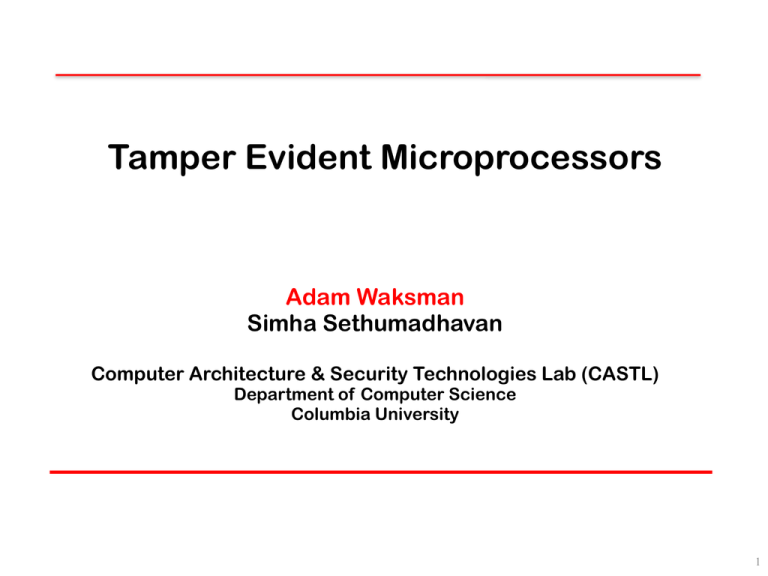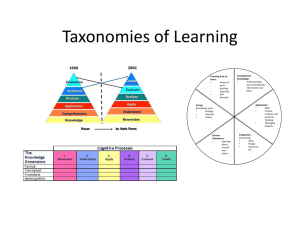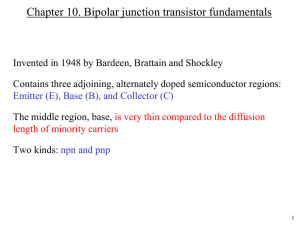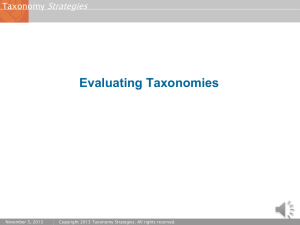Back End Front End
advertisement

Tamper Evident Microprocessors Adam Waksman Simha Sethumadhavan Computer Architecture & Security Technologies Lab (CASTL) Department of Computer Science Columbia University 1 Modern Hardware is Complex • Modern systems built on layers of hardware Applications OS Hypervisor Motherboard/ Slave Chips CPU • Complexity increases risk of backdoors • More hands • Easier to hide • A significant vulnerability • Hardware is the root of trust • All hardware and software controlled by microprocessors Prior Work and Scope • Microprocessor design stages Front End Specification Back End High Level Design Design Validation Physical Design Tapeout/ Fabrication • Prior work focuses on back end • More immediate threat • Example: IC fingerprinting [Agrawal et al., 2007] • Front end is the extreme root • Common assumption: golden model from front end • Focus of this work Deployment Key Idea: Use Inherent Division of Work • Bob Thank you, Bob, for your $90 • Nice Guy • Donates $100 • Eric • Evil Accountant • Steals $10 • Alice • Charity President • Receives $90 Microprocessor Pipeline Stages Analogue Fetch (Bob) Decode (Eric) Execute (Alice) Outline • Taxonomy • Ticking Timebombs, Cheat Codes, Emitters, Corrupters • Solutions • TrustNet and DataWatch • Results • Correctness, Coverage and Costs • Future Work Taxonomy of Attacks • Backdoor = Trigger + Payload • Trigger: Turns on an attack • Payload: Malicious, illegal action Triggers Data Time Payloads Emitter Corrupter Taxonomy of Attacks: Triggers Triggers Data Time Taxonomy of Attacks: Payloads Payloads Emitter • Emitter Attacks • Extra malicious events • Separate from normal events Corrupter • Corrupter Attacks • No extra malicious events • Normal instructions altered Taxonomy of Attacks: Summary Emitter Timebomb Corrupter Timebomb Emitter Cheatcode Corrupter Cheatcode Assumptions • Large design team • Each designer works on one unit or part of one • Security add-ons cannot be done by one member • Full knowledge • Attacker has complete access to all design specifications • Attacker also knows about additional security mechanism • Equal distrust • Any one designer/unit may be evil • Security add-ons may contain backdoors Outline • Taxonomy • Ticking Timebombs, Cheat Codes, Emitters, Corrupters • Solutions • TrustNet and DataWatch • Results • Correctness, Coverage and Costs • Future Work Sample Emitter Backdoor • Consider a malicious instruction decoder • Decoder emits instructions not in the original program • Execution unit faithfully executes them Spurious Output Fetch Decode Execute TrustNet Predictor Fetch Execute Reactor add $r1, $r2, $r3 Decode Target • Predictor and Reactor monitor the Target • Division of work prevents one bad guy from breaking two units • Scaling to larger number increases design complexity Corrupter Backdoors • Bob • Still nice • Donates $100 • Eric • Evil (and smarter) • Converts to Canadian $ • Alice • Still president • Fooled by Eric’s C$100 Thank you, Bob, for your C$100 DataWatch STOP Predictor Fetch Execute Reactor add $r1, $r2, $r3 Decode Target SUB $r1, $r2, $r3 • Scaled up version of TrustNet • Multiple bit messages • Confirms types of messages (instead of just yes/no) Outline • Taxonomy • Ticking Timebombs, Cheat Codes, Emitters, Corrupters • Solutions • TrustNet and DataWatch • Results • Correctness, Coverage and Costs • Future Work Experimental Context, Correctness, Costs • Context • Simplified OpenSPARC T2 • Correctness • Designed attacks • No false positives or negatives • Costs • Low area overhead (2 KB per core) • No performance impact • How to measure coverage? Coverage: Vulnerability Space Units with a core Units with a core Paper has plots for other units at a chip level 18 Coverage Visualization WARNING: This is an approximate vizualization 1919 Summary and Future Work • Strengthen root of trust: microprocessors • Hardware-only solution. No perf impact, low area overhead • Security add-on highly resilient to corruption • Provided attack taxonomy, method to characterize attack space • Applicability of TrustNet & DataWatch • Covered: pipelines, caches and content associative memory • Not covered: ALU, microcode, power mgmt., side-channels • Moving Forward • Expand coverage • Out-of-order processors • Motherboard components ✔ • Design automation tools • Reaction to errors • Applying techniques for reliable execution • First steps toward a secure trusted hardware w/ untrusted units Thank You! and Questions?











